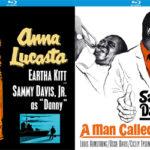Details
In October 1957, Sammy Davis, Jr. was the ‘next big thing’ in show business. He had finished his run on Broadway with Mr. Wonderful and was making hay as a recording artist with Decca Records while criss-crossing the country with his father and ‘uncle’ Will Mastin as a premier nightclub attraction. A starring role in the upcoming film Anna Lucasta and a television debut on General Electric Theater awaited him in 1958.
Given Sammy’s wide name recognition across America, it was an opportune time to capitalise on any Sammy project possible – and Sammy Jumps With Joya was a case in point. It looks for all the world like a duet album with Joya Sherrill, but it isn’t so.
Back in May of 1952, Sammy and the Trio had made a big impression at the Latin Casino in downtown Philadelphia. One of the Casino’s ‘concessionaires’, Harry Rubin, felt that Sammy should be represented on wax. A local business associate of Rubin’s, Joe Diamond, had created a label earlier in the year, Denny Records, to release a single by local singer Art Treat. With that experience behind him, Diamond teamed with Rubin and brother Al Diamond (a beauty shop operator, soon to become theatrical booker) to fund a recording session for Sammy in January 1953.
The resulting release would be on their self-distributed label called DDR (standing for Davis / Diamond / Rubin), and for the time being it was intended to only release songs by Sammy. With music arranged and conducted by Sammy’s in-house musical director Morty Stevens, the session in Philadelphia yielded four cuts. A shellac 78rpm disc was pressed with “Gypsy In My Soul” (the first batch misspelled ‘Gypsy’ as ‘Gypsey’) and an original ballad by songwriter Berl Rotfeld, “Who Needs Spring?”.
Sammy travelled with a box of the records and gave them to anyone and everyone he came across. The other two recordings were a cover of the jazz standard “Chloe” and another original ballad, “Why Do I Worry?”. These songs were left on the shelf, because for some unknown reason the syndicate failed to press any more discs. The sound quality, with significant echo and some audio clipping, befits what might be expected from a one-off independent recording endeavour run by three nightclub bigwigs – it’s pretty terrible.
Fast forward four years to 1957, and Sammy was under contract with Decca Records. Meanwhile, Pickwick Records were about to launch a brand new 33rpm LP arm to their business in the USA, to be called Design Records. Design took Sammy’s four recordings from 1953 and placed them on one of their first LPs, which were released in October. Whether Sammy and his manager, Arthur Silber, had been shopping the four recordings around for some time, or whether Design simply licensed them (unbeknownst to Sammy) isn’t clear, but either way it’s more than likely that Decca wasn’t hugely impressed.
The four cuts are far from Sammy’s best material, as might be expected from his first stint behind a microphone since 1949. In 1953 he was clearly still learning his craft, and in places his sound is indistinguishable from some of his singer impressions (especially Billy Eckstine). After all, it would be another year and change before Decca would come calling and Sammy would begin the process of discovering his ‘own’ sound.

Joya Sherrill
But what would Design do with their LP containing only four songs? To fill the remainder of the album, they added six cuts by jazz singer Joya Sherrill. Sherrill had made her name fronting Duke Ellington’s orchestra during the late 1940s, and was a big drawcard on the nightclub and burlesque circuit. These were Sherrill’s first recordings released commercially under her own aegis, and she gives a good account of her skills across a range of material from “Lush Life” to “Thou Swell”.
Accordingly, Sammy Jumps With Joya isn’t a duet album – despite the valiant efforts to suggest otherwise by the LP’s promotion. For the album cover, Design took an existing photo by Milton Greene of Sammy leaping in the air, and added a shot of poor Joya pretending to look excitedly up at Sammy’s backside. Since Sammy met and befriended almost everyone in show business, it can be safely assumed that he knew Sherrill, but it’s also within the realms of possibility that despite sharing billing on this album, the two never even met. Certainly, being a Decca recording artist at the time, Sammy didn’t promote this Design release.
Track listing
| Track | Record Date | Song | Time |
| A1 | 1/1953 | The Gypsy In My Soul | 2:34 |
| A2 | Sherrill: Baby Me | 3:46 | |
| A3 | 1/1953 | Who Needs Spring? | 2:50 |
| A4 | Sherrill: Lush Life | 3:26 | |
| A5 | Sherrill: Between The Devil And The Deep Blue Sea | 2:14 | |
| B1 | 1/1953 | Chlo-e (Song Of The Swamp) | 2:23 |
| B2 | Sherrill: Thou Swell | 2:00 | |
| B3 | 1/1953 | Why Do I Worry? | 2:59 |
| B4 | Sherrill: Easy Street | 3:42 | |
| B5 | Sherrill: End Of A Love Affair | 2:16 |
TOP TWO TRACKS
![]() The Gypsy In My Soul: Written for the 50th anniversary of the University of Pennsylvania Mask and Wig Show in 1937 by two graduates, Clay Boland and Moe Jaffe, this song was released in 1957 by Sammy twice. A different (superior) version, arranged by Jack Pleis was released on Sammy Swings in May. This 1953 cut still displays the energy and verve that would become Sammy’s trademark in later years. Considered a rarity, this track was chosen to appear on the Rhino Records four-CD retrospective of Sammy’s career, The Sammy Davis, Jr. Story in 1999.
The Gypsy In My Soul: Written for the 50th anniversary of the University of Pennsylvania Mask and Wig Show in 1937 by two graduates, Clay Boland and Moe Jaffe, this song was released in 1957 by Sammy twice. A different (superior) version, arranged by Jack Pleis was released on Sammy Swings in May. This 1953 cut still displays the energy and verve that would become Sammy’s trademark in later years. Considered a rarity, this track was chosen to appear on the Rhino Records four-CD retrospective of Sammy’s career, The Sammy Davis, Jr. Story in 1999.![]() Chlo-e (Song Of The Swamp): Louis Armstrong had released a popular 78 of this show-tune in 1952, and Sammy possibly felt it would nicely demonstrate his vocal chops. He certainly does a nice job telling the song’s story. The song itself, written by Charles N. Daniels (under the pseudonym of ‘Neil Morét’) and Gus Kahn, dates back to 1927 (when it may have appeared in the Broadway show Africana), but had since become an instrumental jazz regular.
Chlo-e (Song Of The Swamp): Louis Armstrong had released a popular 78 of this show-tune in 1952, and Sammy possibly felt it would nicely demonstrate his vocal chops. He certainly does a nice job telling the song’s story. The song itself, written by Charles N. Daniels (under the pseudonym of ‘Neil Morét’) and Gus Kahn, dates back to 1927 (when it may have appeared in the Broadway show Africana), but had since become an instrumental jazz regular.
Release notes
- This album has never received an official CD reissue.
- It can currently be purchased digitally on Amazon.









